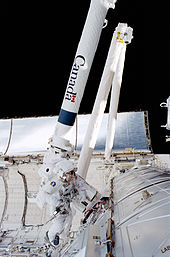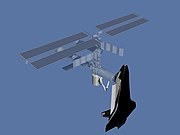
Yury Valentinovich Lonchakov is a Russian former cosmonaut and a veteran of three space missions. He has spent 200 days in space and has conducted two spacewalks. From 2014 to 2017, Lonchakov served as head of the Yuri Gagarin Cosmonaut Training Center.

STS-112 was an 11-day Space Shuttle mission to the International Space Station (ISS) flown by Space ShuttleAtlantis. Space Shuttle Atlantis was launched on 7 October 2002 at 19:45 UTC from the Kennedy Space Center's launch pad 39B to deliver the 28,000 pound Starboard 1 (S1) truss segment to the Space Station. Ending a 4.5-million-mile journey, Atlantis landed at 15:44 UTC on 18 October 2002 on runway 33 at the Kennedy Space Center's Shuttle Landing Facility.
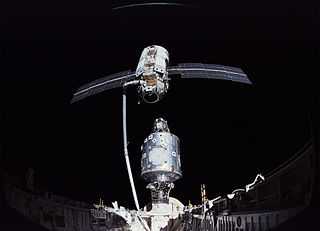
STS-88 was the first Space Shuttle mission to the International Space Station (ISS). It was flown by Space Shuttle Endeavour, and took the first American module, the Unity node, to the station.

STS-96 was a Space Shuttle mission to the International Space Station (ISS) flown by Space Shuttle Discovery, and the first shuttle flight to dock at the International Space Station. The shuttle carried the Spacehab module in the payload, filled with cargo for station outfitting. STS-96 launched from Kennedy Space Center, Florida, on 27 May 1999 at 06:49:42 AM EDT and returned to Kennedy on 6 June 1999, 2:02:43 AM EDT.

STS-106 was a 2000 Space Shuttle mission to the International Space Station (ISS) flown by Space Shuttle Atlantis.
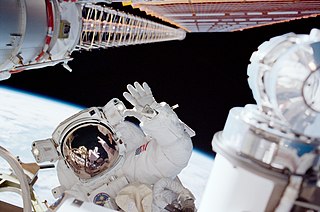
STS-97 was a Space Shuttle mission to the International Space Station (ISS) flown by Space Shuttle Endeavour. The crew installed the first set of solar arrays to the ISS, prepared a docking port for arrival of the Destiny Laboratory Module, and delivered supplies for the station's crew. It was the last human spaceflight of the 20th century.

STS-98 was a 2001 Space Shuttle mission to the International Space Station (ISS) flown by Space Shuttle Atlantis. It was the first human spaceflight launch of the 21st century. STS-98 delivered to the station the Destiny Laboratory Module. All mission objectives were completed and the shuttle reentered and landed safely at Edwards Air Force Base on 20 February 2001, after twelve days in space, six of which were spent docked to the ISS.

STS-102 was a Space Shuttle mission to the International Space Station (ISS) flown by Space Shuttle Discovery and launched from Kennedy Space Center, Florida. STS-102 flew in March 2001; its primary objectives were resupplying the ISS and rotating the Expedition 1 and Expedition 2 crews. At eight hours 56 minutes, the first EVA performed on the mission remains the longest spacewalk ever undertaken.

STS-105 was a mission of the Space Shuttle Discovery to the International Space Station, launched from Kennedy Space Center, Florida, 10 August 2001. This mission was Discovery's final mission until STS-114, because Discovery was grounded for a refit, and then all Shuttles were grounded in the wake of the Columbia disaster. The refit included an update of the flight deck to the glass cockpit layout, which was already installed on Atlantis and Columbia.
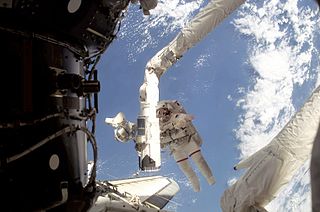
STS-108 was a Space Shuttle mission to the International Space Station (ISS) flown by Space Shuttle Endeavour. Its primary objective was to deliver supplies to and help maintain the ISS.

STS-111 was a space shuttle mission to the International Space Station (ISS) flown by Space Shuttle Endeavour. STS-111 resupplied the station and replaced the Expedition 4 crew with the Expedition 5 crew. It was launched on 5 June 2002, from Kennedy Space Center, Florida.

Expedition 2 was the second long-duration spaceflight aboard the International Space Station, immediately following Expedition 1. Its three-person crew stayed aboard the station from March to August 2001. In addition to station maintenance, the crew assisted in several station assembly missions, welcomed the first space tourist Dennis Tito, and conducted some scientific experiments.

STS-127 was a NASA Space Shuttle mission to the International Space Station (ISS). It was the twenty-third flight of Space ShuttleEndeavour. The primary purpose of the STS-127 mission was to deliver and install the final two components of the Japanese Experiment Module: the Exposed Facility, and the Exposed Section of the Experiment Logistics Module (ELM-ES). When Endeavour docked with the ISS on this mission in July 2009, it set a record for the most humans in space at the same time in the same vehicle, the first time thirteen people have been at the station at the same time. Together they represented all ISS program partners and tied the general record of thirteen people in space with the first such occurrence of 1995.

STS-126 was the one hundred and twenty-fourth NASA Space Shuttle mission, and twenty-second orbital flight of the Space Shuttle Endeavour (OV-105) to the International Space Station (ISS). The purpose of the mission, referred to as ULF2 by the ISS program, was to deliver equipment and supplies to the station, to service the Solar Alpha Rotary Joints (SARJ), and repair the problem in the starboard SARJ that had limited its use since STS-120. STS-126 launched on 15 November 2008 at 00:55:39 UTC from Launch Pad 39A (LC-39A) at NASA's Kennedy Space Center (KSC) with no delays or issues. Endeavour successfully docked with the station on 16 November 2008. After spending 15 days, 20 hours, 30 minutes, and 30 seconds docked to the station, during which the crew performed four spacewalks, and transferred cargo, the orbiter undocked on 28 November 2008. Due to poor weather at Kennedy Space Center, Endeavour landed at Edwards Air Force Base on 30 November 2008 at 21:25:09 UTC.

STS-123 was a Space Shuttle mission to the International Space Station (ISS) which was flown by Space Shuttle Endeavour. STS-123 was the 1J/A ISS assembly mission. The original launch target date was February 14, 2008, but after the delay of STS-122, the shuttle was launched on March 11, 2008. It was the twenty-fifth shuttle mission to visit the ISS, and delivered the first module of the Japanese laboratory, Japanese Experiment Module (Kibō), and the Canadian Special Purpose Dexterous Manipulator, (SPDM) Dextre robotics system to the station. The mission duration was 15 days and 18 hours, and it was the first mission to fully utilize the Station-to-Shuttle Power Transfer System (SSPTS), allowing space station power to augment the shuttle power systems. The mission set a record for a shuttle's longest stay at the ISS.

STS-130 was a NASA Space Shuttle mission to the International Space Station (ISS). Space ShuttleEndeavour's primary payloads were the Tranquility module and the Cupola, a robotic control station with six windows around its sides and another in the center, providing a 360-degree view around the station. Endeavour launched at 04:14 EST on February 8, 2010 and landed at 22:22 EST on February 21, 2010, on runway 15 at the Kennedy Space Center's Shuttle Landing Facility.

STS-132 was a NASA Space Shuttle mission, during which Space Shuttle Atlantis docked with the International Space Station on May 16, 2010. STS-132 was launched from the Kennedy Space Center on May 14, 2010. The primary payload was the Russian Rassvet Mini-Research Module, along with an Integrated Cargo Carrier-Vertical Light Deployable (ICC-VLD). Atlantis landed at the Kennedy Space Center on May 26, 2010.

The Pressurized Mating Adapter (PMA) is a class of spacecraft adapters that convert the Common Berthing Mechanism (CBM) used on the US Orbital Segment to APAS-95 docking ports. There are three PMAs located on the International Space Station (ISS); the first two were launched with the Unity connecting module in 1998 aboard STS-88, and the third was launched in 2000 aboard STS-92. All three of the PMAs are now used to permanently connect parts of the ISS, so they are no longer available as docking ports for visiting spacecraft.
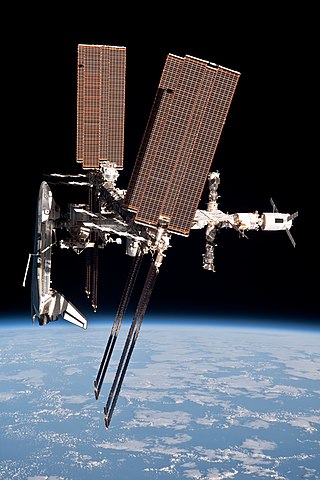
STS-134 was the penultimate mission of NASA's Space Shuttle program and the 25th and last spaceflight of Space ShuttleEndeavour. This flight delivered the Alpha Magnetic Spectrometer and an ExPRESS Logistics Carrier to the International Space Station. Mark Kelly served as the mission commander. STS-134 was expected to be the final Space Shuttle mission if STS-135 did not receive funding from Congress. However, in February 2011, NASA stated that STS-135 would fly "regardless" of the funding situation. STS-135, flown by Atlantis, took advantage of the processing for STS-335, the Launch on Need mission that would have been necessary if the STS-134 crew became stranded in orbit.

STS-135 was the 135th and final mission of the American Space Shuttle program. It used the orbiter Atlantis and hardware originally processed for the STS-335 contingency mission, which was not flown. STS-135 launched on July 8, 2011, and landed on July 21, 2011, following a one-day mission extension. The four-person crew was the smallest of any shuttle mission since STS-6 in April 1983. The mission's primary cargo was the Multi-Purpose Logistics Module (MPLM) Raffaello and a Lightweight Multi-Purpose Carrier (LMC), which were delivered to the International Space Station (ISS). The flight of Raffaello marked the only time that Atlantis carried an MPLM.
